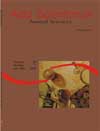Metabolism cage for horses
Abstract
The metabolism cage here proposed was built at FCAV-Unesp, Jaboticabal, state of São Paulo, Brazil, and used in the Animal Science Laboratory at Cena-USP, Piracicaba, state of São Paulo, Brazil. The equipment allows to host male horses from weaning to adult age. Before starting the experiment, the animals were daily conditioned for a 30-day period to remain in the cage. The necessary material and the building process of the horse metabolic cage are described and illustrated. The main structure of the cage (2.68m long x 0.80 m wide x 2.02 m high) was made of 2-inch-diameter metal tube, and all the support units-floor board, urine bars, watering trough, feeder, urine collecting tray, and contention bars-were attached to the main structure but removable in order to make management and equipment cleaning easier. The equipment was designed to host animals of different sizes and be totally efficient in sampling urine and feces, and also in providing water and food. The animals remained standing during all the confinement without causing serious limb edemas. The proposed model was tested in experiments of phosphorus metabolism using radioscopy.Downloads
Download data is not yet available.
Published
2008-05-13
How to Cite
Furtado, C. E., Tosi, H., & Vitti, D. M. S. S. (2008). Metabolism cage for horses. Acta Scientiarum. Animal Sciences, 22, 813-816. https://doi.org/10.4025/actascianimsci.v22i0.3223
Issue
Section
Animal Science
DECLARATION OF ORIGINALITY AND COPYRIGHTS
- I Declare that current article is original and has not been submitted for publication, in part or in whole, to any other national or international journal.
The copyrights belong exclusively to the authors. Published content is licensed under Creative Commons Attribution 4.0 (CC BY 4.0) guidelines, which allows sharing (copy and distribution of the material in any medium or format) and adaptation (remix, transform, and build upon the material) for any purpose, even commercially, under the terms of attribution.
Read this link for further information on how to use CC BY 4.0 properly.
0.9
2019CiteScore
29th percentile
Powered by 








































